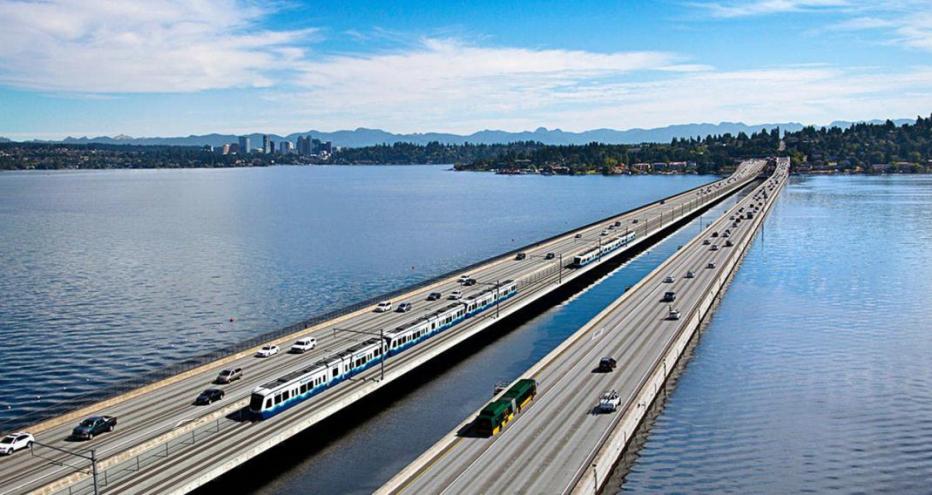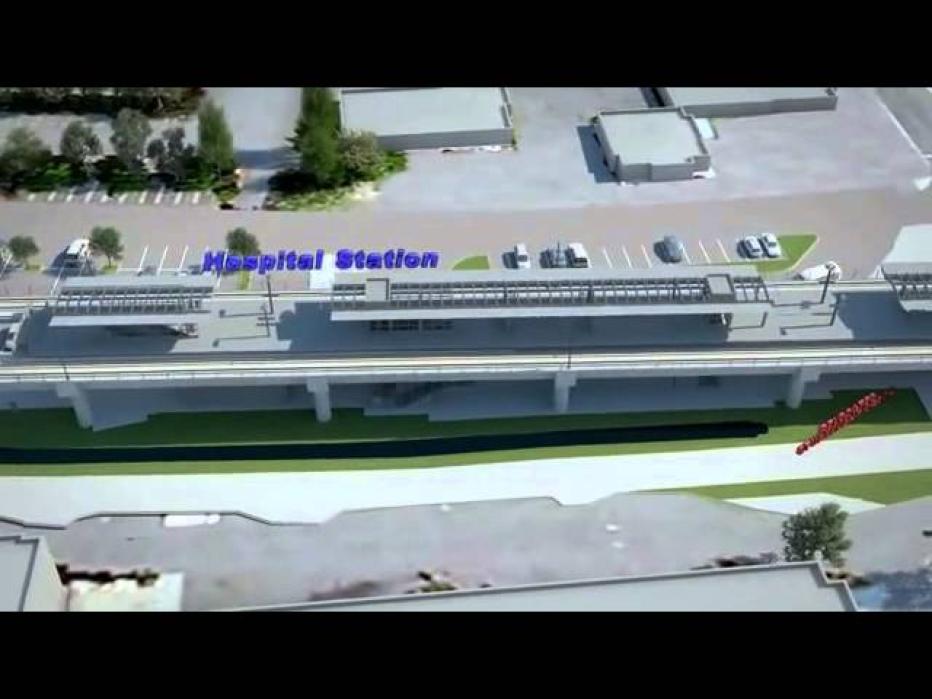
As part of the overall extension of Sound Transit’s light rail from Seattle to Redmond, Washington, the I-90 Segment of the East Link Light Rail Extension Project extends light rail service from the existing International District Station (IDS) in Seattle, eastwards to Mercer Island. This project features two prototype construction elements; the track attachment on the floating bridge (involving lightweight concrete plinths with a commercial grade ‘rubber’ base, attached to the bridge with a high-strength epoxy) and eight track bridges which transition the rail from the fixed to floating structures.
The 7-miles of track is predominantly on existing Washington Department of Transportation (WSDOT) roadways and aerial structures, through two existing WSDOT tunnels (Mount Baker Tunnel and the Mercer Island Lid), across the existing I-90 Floating Bridge and includes two at-grade stations and four traction power substations. The new east/west alignment ties into the operational north/south alignment – the tie in was successfully completed in 12 weeks of single-track operations of the existing light rail system. Jacobs is providing construction management (CM) services with a planned completion in early 2021.
Watch: East Link Extension Alignment Animation

-
1
of the first “Heavy-Civil GCCM” type contracts utilized in Washington
-
3 K
LF of external post tensioning of the floating bridge
-
1 st
of a kind prototype track construction on a floating bridge
-
8
track bridges being installed, that transition the rail from the static, land side to the moveable floating bridge side
“This project has been the most challenging and rewarding project I have been involved in. It seems like every element brings a new challenge. Constructing on a floating bridge is tantamount to building on a ship with every element being bought on and off needing to be accounted for. In addition to the obvious protype construction (3,000 LF of post tensioning inside concrete pontoons floating in Lake Washington and installing rail on a floating bridge) there are significant daily challenges that have to be overcome as a result of constructing on a 40’ wide existing roadway in between a major freeway. The collaboration between the CM team, Sound Transit, the design team, the contractor and WSDOT has been the reason for the successes the project has realized to-date.”

A Look at the Sound Transit East Link
Phase 1, or preconstruction services which began in December 2015, included providing constructability and value engineering reviews as the design advanced from approximately 30-60% through to IFC. Over 3,500 constructability comments were made and incorporated into the design. Value engineering efforts identified over $20 million of potential cost savings of which $18 million were realized.
Additional services included support for Sound Transit, developing construction estimates at 60% and 90% design, overseeing the competitive bid process for subcontract packages, developing a ‘mini’ Maximum Allowable Construction Contract (MACC) to allow for the early procurement critical path, post tensioning anchor frame steel, and successful negotiation of the $650 million construction contract which also included $15 million in post-award cost savings.
During Phase 2 (construction) which began in June of 2017, Jacobs is providing full construction management services, including project management resident engineering, construction engineering, office engineering, field engineering, document control, administration, inspection and safety and environmental oversight, in addition to cost estimating, scheduling, risk analysis/management and change order management.
The project has overcome many challenges and has, to-date, submitted five value plus ideas saving millions of dollars and significant schedule savings. Challenges and solutions include:
CM and Inspection Components
Seismic and gravity structural retrofit of the existing structures involved a wide variety of construction techniques and activities each requiring unique solutions. Steel plate retrofit to the East Channel Bridge, an existing steel tub girder bridge, required the use of scaffolding suspended from the bridge 80’ above Lake Washington to gain access to the underside of the bridge girder. This prevented the need for costly barges and cranes.
Several structures had existing utilities on/around them, which were required to be relocated prior to work being performed. Work was completed over/around active road and freeways and live train operations and included both daytime and nighttime activities. Traffic control was a large focus to make sure work was executed safely with minimal impact to the traveling public. In addition, the Jacobs CM team coordinated with King County Metro for inspections around the active railway for the required oversight during this work.
OE/Document Control
Due to the nature of the work, as-built information and revisions to design details were reviewed by multiple parties and quickly addressed to maintain the timely execution of work. Completion of each component of work required formal sign-off early to allow for removal of work decks and access. Inspection daily reports were collected and organized to develop complete packages of information for WSDOT in order to formally sign off on the completion of each area as work was finished.
Relevant Interface/Coordination
Close cooperation was maintained between various agencies and stakeholders, most notably between WSDOT (the owner of the fixed structures) and Sound Transit (the agency managing construction and operating the light rail system). The changes and unforeseen conditions inherent to structural retrofit necessitated constant and timely communication and coordination between the contractor, subcontractors, Jacobs (CM), WSDOT, Sound Transit and the Engineer of Record in order to correctly and expeditiously manage changes and issues. Weekly discipline meetings gave a collaborative forum to address and resolve issues and make sure that formal documentation and questions were processed promptly.
Discover More
Rail Group On Air: First of it’s Kind—Building a Floating Rail Bridge












































